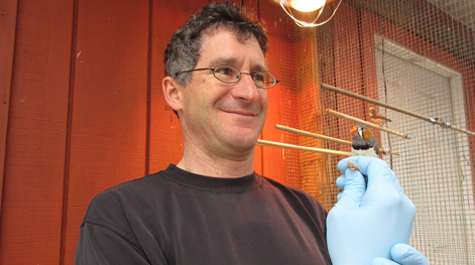William & Mary researchers provide science leading to $50 million DuPont settlement
A group of William & Mary researchers led by Dan Cristol provided scientific evidence supporting a $50 million settlement resulting from decades-old mercury pollution.
A press release from Virginia Gov. Terry McAuliffe’s office today announced the settlement with DuPont resolved claims related to the release of mercury from the former E.I. du Pont de Nemours and Company (DuPont) facility in Waynesboro. The mercury release contaminated more than 100 miles of river and associated floodplain in the South River and South Fork Shenandoah River watershed.
The Dec. 15 settlement, announced jointly by the commonwealth and the U.S. Departments of Justice and Interior, provides for a cash payment of just over $42 million. In addition, DuPont will fund the design and implementation of significant renovations at the Front Royal Fish Hatchery, estimated to cost up to $10 million. The settlement terms are outlined in a proposed consent decree filed in federal court in Harrisonburg, which cited the work of Cristol and his collaborators.
Cristol, a professor of biology at William & Mary, began investigating the effects of mercury on birds in the contaminated area in 2005. He led a team of William & Mary students who examined the levels and effects of mercury on the birds, both resident and migratory. Over the next decade, Cristol teamed up with biology department faculty colleagues John Swaddle, Eric Bradley, Margaret Saha, Willie Buchser, Lizabeth Allison, Matthias Leu and Patty Zwollo, and more than 50 William & Mary students, to examine how mercury enters the food chain and harms birds.
The focus of their research was on methylated mercury, which he explained was a highly toxic set of mercury compounds that are the results of processing by bacteria. Methylated mercury is the form that does the most environmental harm, he said.
“Once bacteria work on mercury and methylate it — metabolizing it, basically — it can go through any cell membrane, right into the blood stream,” Cristol explained. “It will adhere to protein and may stay with you forever.”
The settlement indicates that DuPont will provide the funds to government natural resource trustees, who will oversee the implementation of projects compensating the public for the natural resource injuries and associated losses in ecological and recreational services, such as enjoying fishing and birdwatching.
“This remarkable settlement will help restore the precious natural resources of the South Fork Shenandoah watershed, bringing lasting benefits for future generations of Virginians to enjoy,” said Assistant Attorney General John C. Cruden for the Justice Department’s Environment and Natural Resources Division. “This joint action with the Department of the Interior and the Commonwealth of Virginia is yet another testament to the value and effectiveness of cooperative federalism in action and I am grateful to all of our partners for the efforts that brought us to this resolution.”
“Today’s settlement, the largest of its kind in Virginia history, is the culmination of a coordinated effort by countless partners at both the state and federal level,” said Governor Terry McAuliffe. “Thanks to their hard work, Virginians and the environment will benefit from unprecedented investments in land conservation and habitat restoration. I applaud and appreciate the meticulous monitoring by our state agencies, the thorough analysis of the scientific advisory committee, and DuPont’s willingness to come to the table and make this happen.”
The release from the governor’s office noted that mercury was released into the South River from the DuPont facility in the 1930s and 1940s. Cristol’s research demonstrated that the mercury continues to persist in the environment, showing a tendency to “get stuck” in the food chain, endlessly recycling between the river, the animals and the soil. The release noted that monitoring data collected over the last 20 years indicates that mercury levels remain elevated, with no clear decreases over time.
“Clean air, water and land are environmental priorities and economic assets that make Virginia a great place to live, work and raise a family,” said Virginia Attorney General Mark Herring in the press release. “We have an obligation to protect these assets for future generations and this record-setting settlement shows that we take our responsibilities seriously. This settlement will allow us to protect and enhance lands throughout the Shenandoah Valley and improve the quality of water for wildlife, anglers, paddlers and others who use these waterways for recreation.”
Cristol has worked on mercury-contaminated wildlife issues since 2005, and his South River research was substantially funded by DuPont.. He and his collaborators have written dozens of papers about the effects of mercury in birds, and he has tested his field findings under controlled laboratory conditions. His new lab in William & Mary’s recently opened Integrated Science Center Phase 3 is equipped with a new methylmercury analyzer, an addition made possible through a challenge grant program by the Cabell Foundation.
“The controlled studies are kind of a check on what we find in the field,” he said. “In the field, it’s all correlational. The aviary studies let us show that there’s actually cause and effect with the mercury.”
A statement from Mike Liberati, South River project director for the DuPont Corporate Remediation Group, outlined the firm’s participation in the settlement.
“In keeping with its long history of cooperation with, and participation in, government initiatives, and its ongoing support of the local community, DuPont is committed to a long-term presence in the Waynesboro area and to maintaining transparency with its citizens,” Liberati’s statement read.
The DuPont release noted that the company also partnered with local universities on curriculum-based classroom projects and sponsored civic and cultural events, park enhancements and educational outreach initiatives. The company also funds the South River Science Team which is run by the Virginia Department of Environmental Quality and conducts testing and evaluation of the river’s water quality. Cristol’s William & Mary group worked actively with the South River Science Team, presenting research updates and attending quarterly meetings.















